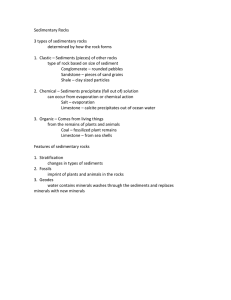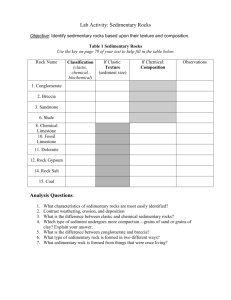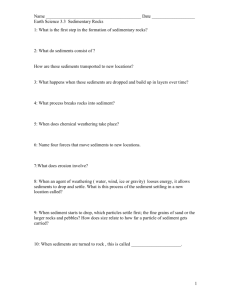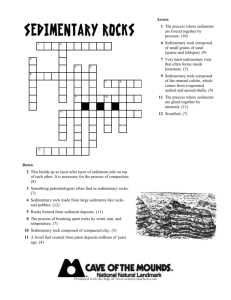Name __________________________________________ Date _______________________ Block _______ Warmup: SEDIMENTARY ROCKS (SR)
advertisement
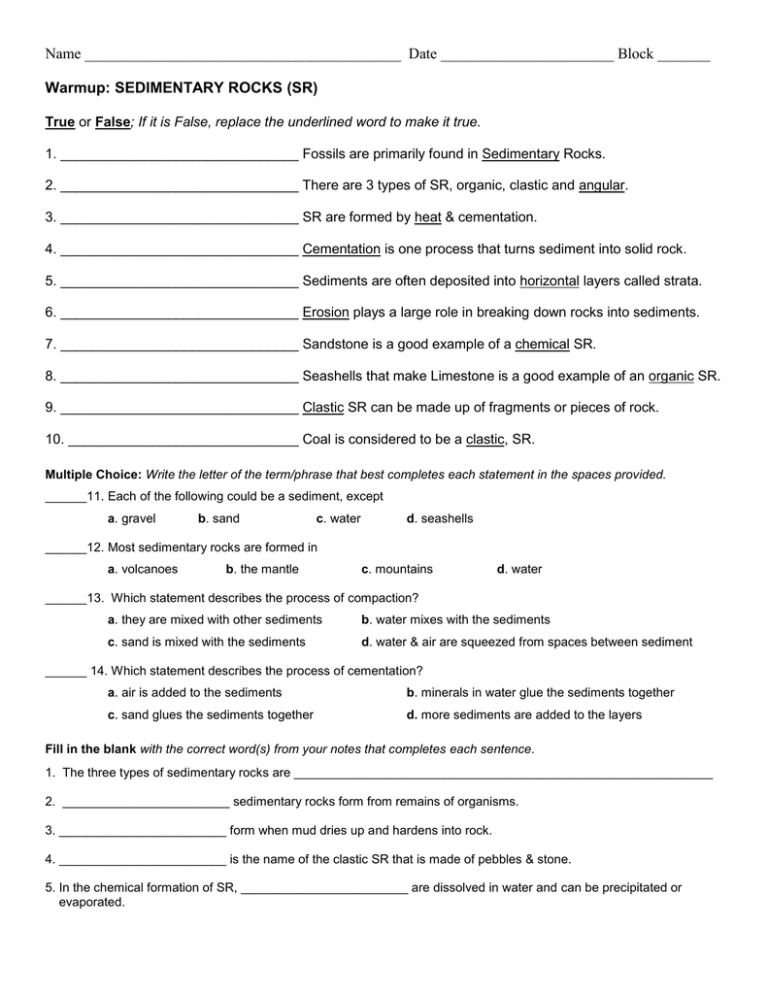
Name __________________________________________ Date _______________________ Block _______ Warmup: SEDIMENTARY ROCKS (SR) True or False; If it is False, replace the underlined word to make it true. 1. _______________________________ Fossils are primarily found in Sedimentary Rocks. 2. _______________________________ There are 3 types of SR, organic, clastic and angular. 3. _______________________________ SR are formed by heat & cementation. 4. _______________________________ Cementation is one process that turns sediment into solid rock. 5. _______________________________ Sediments are often deposited into horizontal layers called strata. 6. _______________________________ Erosion plays a large role in breaking down rocks into sediments. 7. _______________________________ Sandstone is a good example of a chemical SR. 8. _______________________________ Seashells that make Limestone is a good example of an organic SR. 9. _______________________________ Clastic SR can be made up of fragments or pieces of rock. 10. ______________________________ Coal is considered to be a clastic, SR. Multiple Choice: Write the letter of the term/phrase that best completes each statement in the spaces provided. ______11. Each of the following could be a sediment, except a. gravel b. sand c. water d. seashells ______12. Most sedimentary rocks are formed in a. volcanoes b. the mantle c. mountains d. water ______13. Which statement describes the process of compaction? a. they are mixed with other sediments b. water mixes with the sediments c. sand is mixed with the sediments d. water & air are squeezed from spaces between sediment ______ 14. Which statement describes the process of cementation? a. air is added to the sediments b. minerals in water glue the sediments together c. sand glues the sediments together d. more sediments are added to the layers Fill in the blank with the correct word(s) from your notes that completes each sentence. 1. The three types of sedimentary rocks are ____________________________________________________________ 2. ________________________ sedimentary rocks form from remains of organisms. 3. ________________________ form when mud dries up and hardens into rock. 4. ________________________ is the name of the clastic SR that is made of pebbles & stone. 5. In the chemical formation of SR, ________________________ are dissolved in water and can be precipitated or evaporated. Classifying SR --- Read the directions!!! For each sedimentary rock in the table, decide whether it is clastic, chemical or organic. Place a check mark in the correct column. In the last column of the table, write the name of the sediment type that forms each rock. CLASSIFYING SEDIMENTARY ROCKS Rock Name Clastic Chemical Organic Forms From 1. Coal 2. Sandstone 3. Rock Salt 4. Shale 5. Coquina (shell Limestone) 6. Limestone (found in caves) 7. Conglomerate Skill Challenge --- Match each diagram with its caption by writing the letter of the correct caption in the space provided. CAPTIONS: a. More layers of sediment form. b. Older sediment becomes rock under the weight of the upper layers, which squeeze out water and air. c. The sediment settles to the ocean bottom. d. Sediment is added to ocean water. Figure 1: Caption _____________ Figure 3: Caption _____________ Figure 2: Caption _____________ Figure 4: Caption _____________



